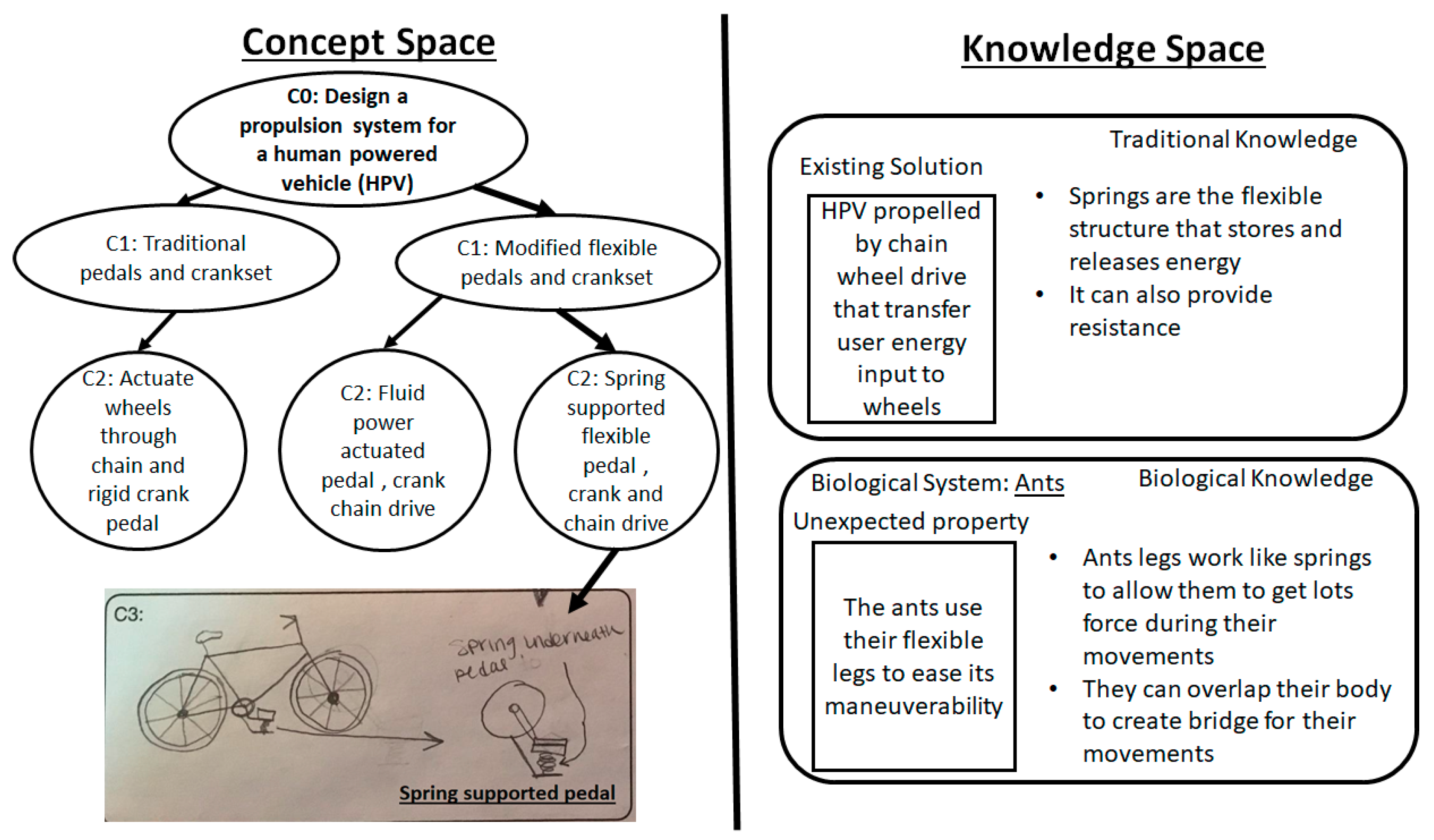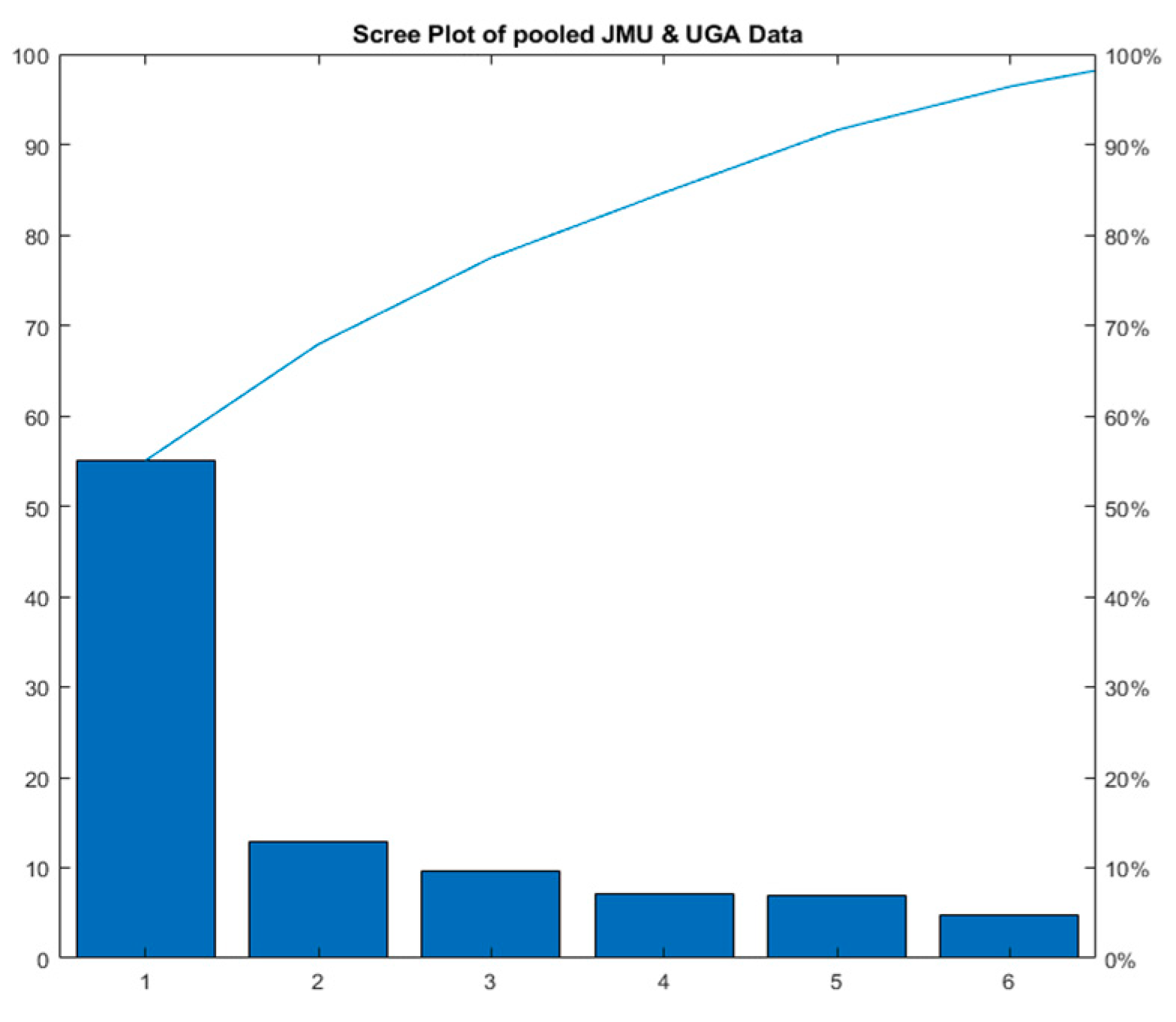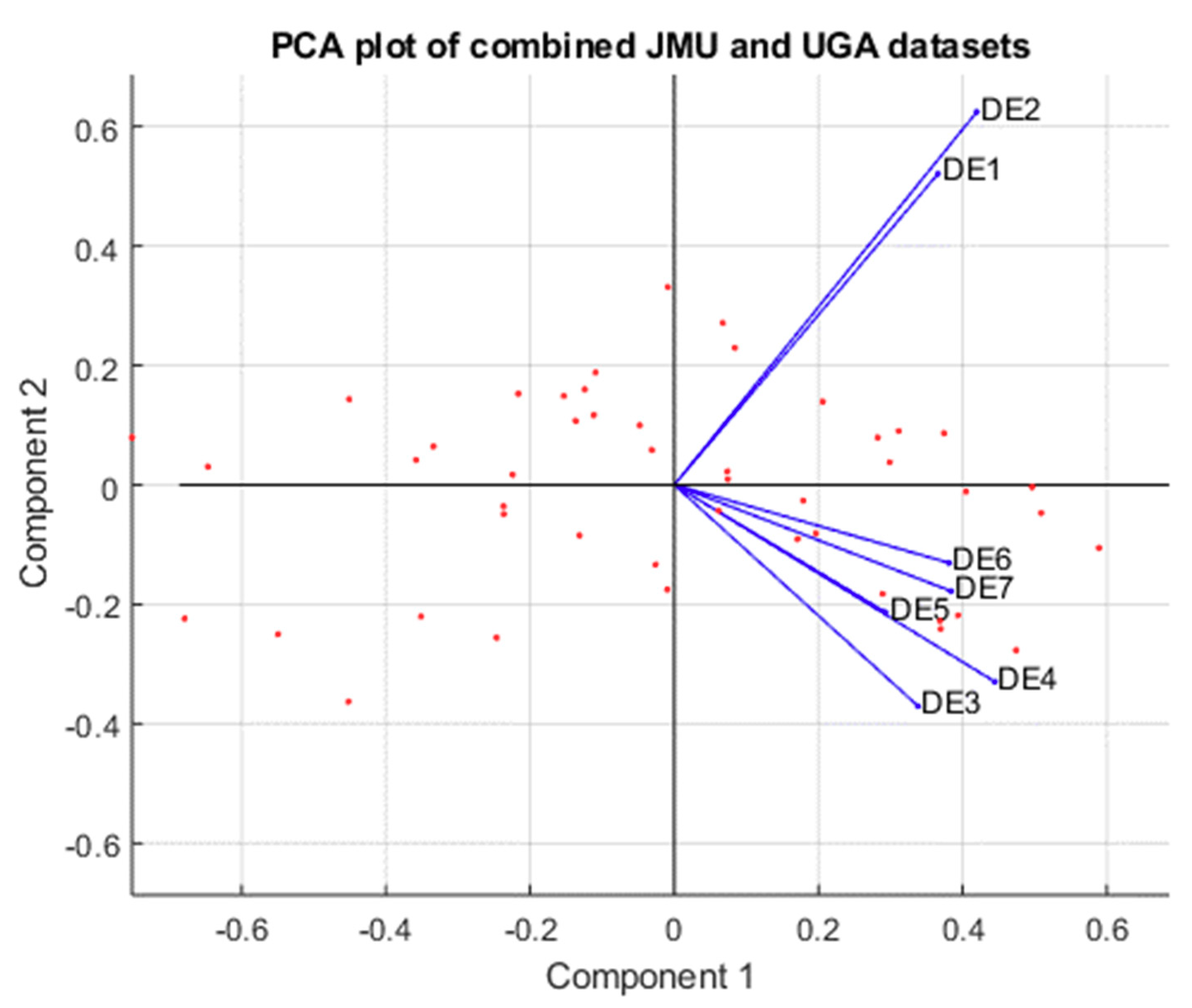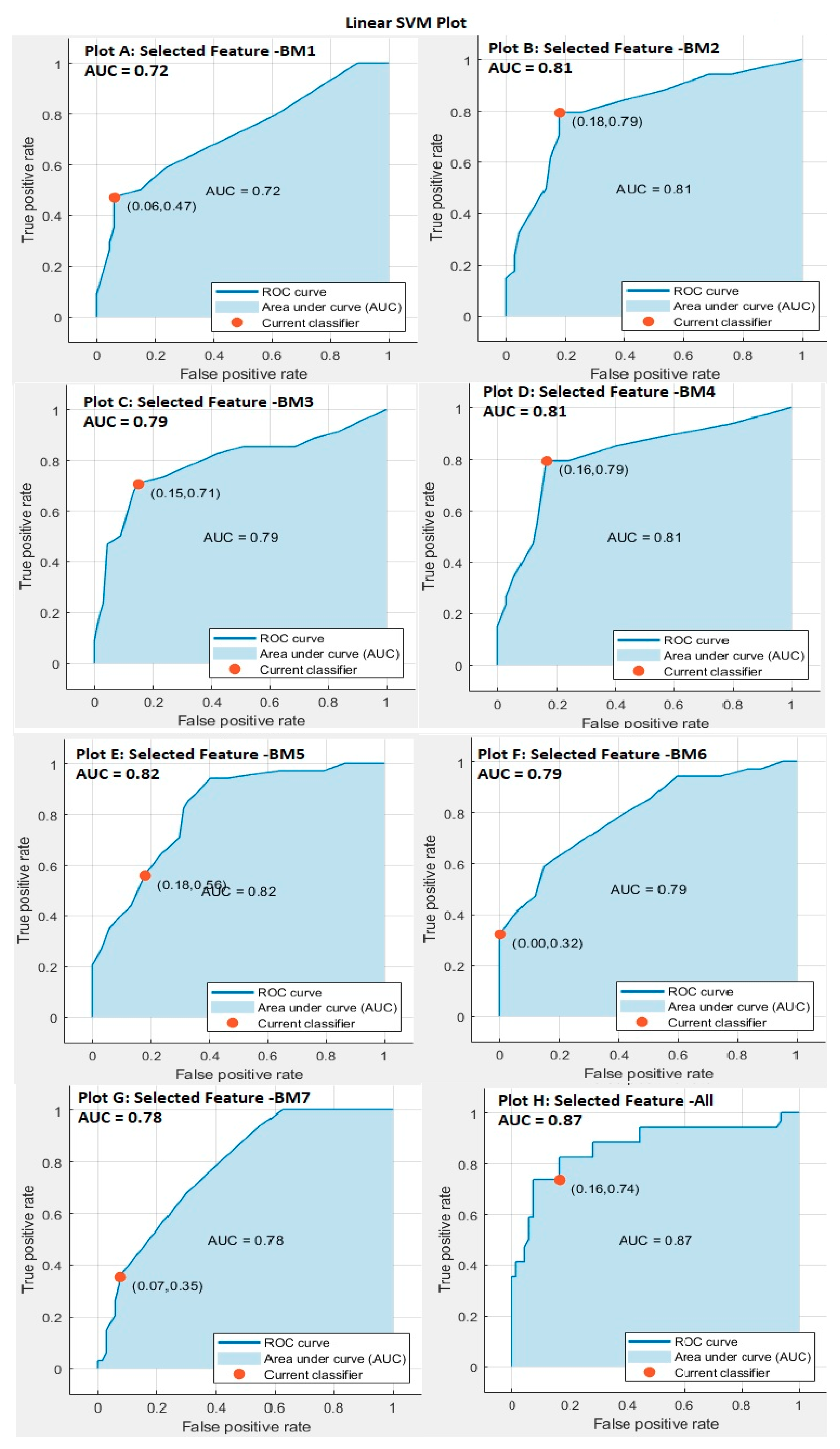Investigation of C-K Theory Based Approach for Innovative Solutions in Bioinspired Design
Abstract
:1. Introduction
2. Methods
2.1. C-K Theory Based Bioinspired Design Process
2.2. Motivational Data for Statistical Analysis
2.3. Evaluation Protocol for Design Performance
2.4. Application of Performance Measurement Protocol
2.5. Statistical Analysis
3. Results and Discussion
3.1. Two Sample Kolmogorov-Smirnov Test
3.2. On Design Engineering Attributes Dimensions Reduction by PCA
3.3. SVM Classification Analysis
4. Conclusions
Author Contributions
Funding
Acknowledgments
Conflicts of Interest
References
- Andriopoulos, C.; Lewis, M.W. Managing innovation paradoxes: Ambidexterity lessons from leading product design companies. Long Range Plan. 2010, 43, 104–122. [Google Scholar] [CrossRef]
- Cross, N. Descriptive models of creative design: Application to an example. Des. Stud. 1997, 18, 427–440. [Google Scholar] [CrossRef]
- Gero, J.S.; Mc Neill, T. An approach to the analysis of design protocols. Des. Stud. 1998, 19, 21–61. [Google Scholar] [CrossRef]
- Dorst, K.; Cross, N. Creativity in the design process: Co-evolution of problem—Solution. Des. Stud. 2001, 22, 425–437. [Google Scholar] [CrossRef]
- Schønheyder, J.F.; Nordby, K. The use and evolution of design methods in professional design practice. Des. Stud. 2018, 58, 36–62. [Google Scholar] [CrossRef]
- Bar-Cohen, Y. Biomimetics—Using nature to inspire human innovation. Bioinspiration Biomim. 2006, 1, 1–12. [Google Scholar] [CrossRef] [PubMed]
- Moreno, D.P.; Hernández, A.A.; Yang, M.C.; Otto, K.N.; Hölttä-Otto, K.; Linsey, J.S.; Wood, K.L.; Linden, A. Fundamental studies in design-by-analogy: A focus on domain-knowledge experts and applications to transactional design problems. Des. Stud. 2014, 35, 232–272. [Google Scholar] [CrossRef]
- Helms, M.; Vattam, S.S.; Goel, A.K. Biologically inspired design: Process and products. Des. Stud. 2009, 30, 606–622. [Google Scholar] [CrossRef]
- Nagel, J.K. Systematic bio-inspired design: How far along are we? Insight 2016, 19, 32–35. [Google Scholar] [CrossRef]
- Nagel, J.K.; Stone, R.B. A systematic approach to biologically-inspired engineering design. In Proceedings of the ASME 2011 International Design Engineering Technical Conferences and Computers and Information in Engineering Conference, Washington, DC, USA, 28–31 August 2011; pp. 153–164. [Google Scholar]
- Vandevenne, D.; Verhaegen, P.A.; Dewulf, S.; Duflou, J.R. Product and organism aspects for scalable systematic biologically-inspired design. Proc. Eng. 2015, 131, 784–791. [Google Scholar] [CrossRef]
- Kennedy, E.; Niewiarowski, P. Biomimicry: Do frames of inquiry support search and identification of biological models? Designs 2018, 2, 27. [Google Scholar] [CrossRef]
- Nagel, J.K.; Stone, R.B.; McAdams, D. An engineering-to-biology thesaurus for engineering design. In Proceedings of the ASME 2010 International Design Engineering Technical Conferences and Computers and Information in Engineering Conference, Montreal, QC, Canada, 15–18 August 2010. [Google Scholar]
- Nagel, J.K.; Stone, R.B.; McAdams, D.A. Function-based biologically inspired design. In Biologically Inspired Design: Computational Methods and Tools; Goel, A.K., McAdams, D.A., Stone, R.B., Eds.; Springer: London, UK, 2014; pp. 95–125. [Google Scholar]
- Ulhøi, J.P. Framing biomimetics in a strategic orientation perspective (biopreneuring). Technol. Anal. Strateg. Manag. 2015, 27, 300–313. [Google Scholar] [CrossRef]
- Hatchuel, A.; Weil, B. A new approach of innovative design: An introduction to CK theory. In Proceedings of the ICED 03, the 14th International Conference on Engineering Design, Stockholm, Sweden, 19–21 August 2003; pp. 109–110. [Google Scholar]
- Hatchuel, A.; Weil, B. C-K design theory: An advanced formulation. Res. Eng. Des. 2009, 19, 181–192. [Google Scholar] [CrossRef]
- Hatchuel, A.; Le Masson, P.; Weil, B. The design of science based products: An interpretation and modelling with C-K theory. In Proceedings of the 9th International Design Conference, DESIGN 2006, Dubrovnik, Croatia, 15–18 May 2006; pp. 33–44. [Google Scholar]
- Salgueiredo, C.F.; Hatchuel, A. Modeling biologically inspired design with the C-K design theory. In Proceedings of the DESIGN 2014 13th International Design Conference, Dubrovnik, Croatia, 19–22 May 2014; pp. 23–32. [Google Scholar]
- Salgueiredo, C.F.; Hatchuel, A. Beyond analogy: A model of bioinspiration for creative design. Artif. Intell. Eng. Des. Anal. Manuf. 2016, 30, 159–170. [Google Scholar] [CrossRef] [Green Version]
- Nagel, J.K.; Stone, R.B. Teaching biomimicry in the context of engineering design. In Proceedings of the Biomimicry in Higher Education Webinar, Missoula, MT, USA, 29 January 2011; pp. 61–68. [Google Scholar]
- Nagel, J.K.; Pidaparti, R.M. Significance, prevalence and implications for bio-inspired design courses in the undergraduate engineering curriculum. In Proceedings of the ASME 2016 International Design Engineering Technical Conferences and Computers and Information in Engineering Conference, Charlotte, NC, USA, 21–24 August 2016. [Google Scholar]
- Nagel, J.; Pittman, P.; Pidaparti, R.; Rose, C.; Beverly, C. Teaching bioinspired design using C–K theory. Bioinspired Biomim. Nanobiomater. 2017, 6, 1–10. [Google Scholar] [CrossRef]
- Hatchuel, A.; Le Masson, P.; Weil, B. C-K theory: Modelling creative thinking and its impact on research. In Creativity, Design Thinking and Interdisciplinarity; Springer: Berlin, Germany, 2017; pp. 169–183. [Google Scholar]
- Weidner, B.V.; Nagel, J.; Weber, H.-J. Facilitation method for the translation of biological systems to technical design solutions. Int. J. Des. Creat. Innov. 2018, 6, 211–234. [Google Scholar] [CrossRef]
- Safoutin, M.J.; Atman, C.J.; Adams, R.; Rutar, T.; Kramlich, J.C.; Fridley, J.L. A design attribute framework for course planning and learning assessment. IEEE Trans. Educ. 2000, 43, 188–199. [Google Scholar] [CrossRef]
- Woollacott, L.C. Validating the CDIO syllabus for engineering education using the taxonomy of engineering competencies. Eur. J. Eng. Educ. 2009, 34, 545–559. [Google Scholar] [CrossRef]
- Hildebrand, D.K. Analysis of Ordinal Data; Sage Publications: Beverly Hills, CA, USA, 1977. [Google Scholar]
- Corder, G.W. Nonparametric Statistics for Non-Statisticians a Step-By-Step Approach; Wiley: Hoboken, NJ, USA, 2009. [Google Scholar]
- Granato, D.; Santos, J.S.; Escher, G.B.; Ferreira, B.L.; Maggio, R.M. Use of principal component analysis (PCA) and hierarchical cluster analysis (HCA) for multivariate association between bioactive compounds and functional properties in foods: A critical perspective. Trends Food Sci. Technol. 2018, 72, 83–90. [Google Scholar] [CrossRef]
- Zhu, M.; Ghodsi, A. Automatic dimensionality selection from the scree plot via the use of profile likelihood. Comput. Stat. Data Anal. 2006, 51, 918–930. [Google Scholar] [CrossRef]
- Abdi, H.; Williams, L.J. Principal component analysis. Wiley Interdiscip. Rev. Comput. Stat. 2010, 2, 433–459. [Google Scholar] [CrossRef]
- Aouabdi, S.; Taibi, M.; Bouras, S.; Boutasseta, N. Using multi-scale entropy and principal component analysis to monitor gears degradation via the motor current signature analysis. Mech. Syst. Signal Process. 2017, 90, 298–316. [Google Scholar] [CrossRef]
- Nobi, A.; Alam, S.; Lee, J.W. Dynamic of consumer groups and response of commodity markets by principal component analysis. Phys. A Stat. Mech. Its Appl. 2017, 482, 337–344. [Google Scholar] [CrossRef]
- Burges, C.J.C. A tutorial on support vector machines for pattern recognition. Data Min. Knowl. Discov. 1998, 2, 121–167. [Google Scholar] [CrossRef]
- Ling, C.X.; Huang, J.; Zhang, H. AUC: A better measure than accuracy in comparing learning algorithms. In Proceedings of the 16th Conference of the Canadian Society for Computational Studies of Intelligence, AI 2003, Halifax, NS, Canada, 11–13 June 2003; pp. 329–341. [Google Scholar]
- Joachims, T. Text categorization with support vector machines: learning with many relevant features. In Proceedings of the 10th European Conference on Machine Learning, Chemnitz, Germany, 21–23 April 1998; pp. 137–142. [Google Scholar]
- Lin, S.-W.; Lee, Z.-J.; Chen, S.-C.; Tseng, T.-Y. Parameter determination of support vector machine and feature selection using simulated annealing approach. Appl. Soft Comput. 2008, 8, 1505–1512. [Google Scholar] [CrossRef]
- Hatchuel, A.; Le Masson, P.; Weil, B. Learning to Face the Unknown and the Emergent: A Project-Based Critical Learning Perspective; European Academy of Management: Ljublana, Slovenia, 2008; p. 19. [Google Scholar]
- Hatchuel, A.; Le Masson, P.; Weil, B. Teaching innovative design reasoning: How concept–knowledge theory can help overcome fixation effects. Artif. Intell. Eng. Des. Anal. Manuf. 2011, 25, 77–92. [Google Scholar] [CrossRef]
- Agogué, M.; Le Masson, P.; Dalmasso, C.; Houdé, O.; Cassotti, M. Resisting classical solutions: The creative mind of industrial designers and engineers. Psychol. Aesthet. Creat. Arts 2015, 9, 313–318. [Google Scholar] [CrossRef]
- Agogué, M.; Poirel, N.; Pineau, A.; Houdé, O.; Cassotti, M. The impact of age and training on creativity: A design-theory approach to study fixation effects. Think. Ski. Creat. 2014, 11, 33–41. [Google Scholar] [CrossRef] [Green Version]





| Biomimicry Attributes (BM) | Design Engineering Attributes (DE) |
|---|---|
| Relating Biological Property (BM1) | Imagination (DE1) |
| Biological knowledge (BM2) | Innovation (DE2) |
| Traditional knowledge (BM3) | Problem definition (DE3) |
| Defined Rough idea (BM4) | Defining Solution Methods (DE4) |
| Transition from rough idea to sketch (BM5) | Decision making (DE5) |
| Definition of design path (BM6) | Implementation and improvement (DE6) |
| Sketches/design output (BM7) | Active participation (DE7) |
| Score Value | Criteria |
|---|---|
| 4 | For a feasible and innovative design solution generated by relating biological knowledge, with a clear understanding of biological and traditional knowledge, and well-defined/highly creative concepts and ideas with a well-defined design path which was evolved due to logically connected decisions and with well-mapped traditional and biological knowledge that led to creative solution of design problems |
| 3 | For feasible design solutions with few existing design features , some missing biological property relations, moderate explanation of biological and traditional knowledge, design concepts with a moderately defined design path and with moderately linked traditional and biological knowledge for solution of design problems |
| 2 | For the design solution with suggested improvements , fewer or missing biological property relations, lower level explanation of biological and traditional knowledge, design concepts with a roughly defined design path and with roughly linked traditional and biological knowledge for solving design problems |
| 1 | For design solutions with least feasibility, poorly related biological properites, poor explanation of biological and traditional knowledge, design concepts with an unclear design path and with poorly linked traditional and biological knowledge for solution of design problems |
© 2019 by the authors. Licensee MDPI, Basel, Switzerland. This article is an open access article distributed under the terms and conditions of the Creative Commons Attribution (CC BY) license (http://creativecommons.org/licenses/by/4.0/).
Share and Cite
Graceraj P., P.; Nagel, J.K.; Rose, C.S.; Pidaparti, R.M. Investigation of C-K Theory Based Approach for Innovative Solutions in Bioinspired Design. Designs 2019, 3, 39. https://doi.org/10.3390/designs3030039
Graceraj P. P, Nagel JK, Rose CS, Pidaparti RM. Investigation of C-K Theory Based Approach for Innovative Solutions in Bioinspired Design. Designs. 2019; 3(3):39. https://doi.org/10.3390/designs3030039
Chicago/Turabian StyleGraceraj P., Prabaharan, Jacquelyn K. Nagel, Christopher S. Rose, and Ramana M. Pidaparti. 2019. "Investigation of C-K Theory Based Approach for Innovative Solutions in Bioinspired Design" Designs 3, no. 3: 39. https://doi.org/10.3390/designs3030039




